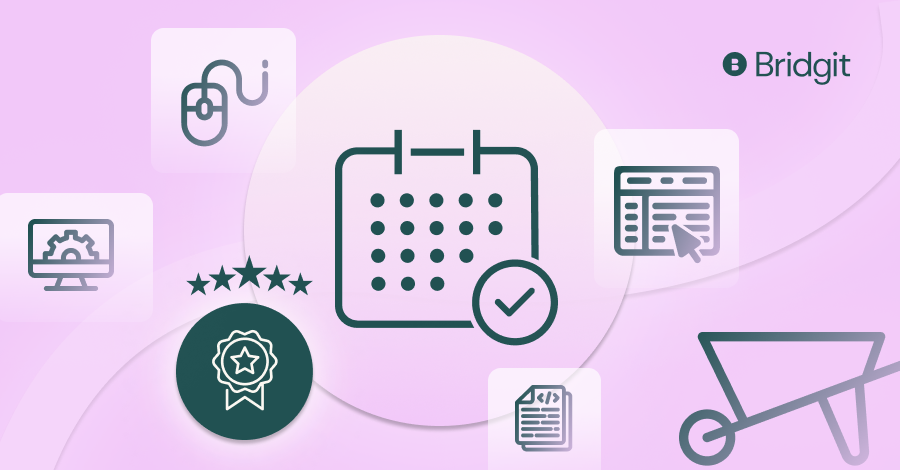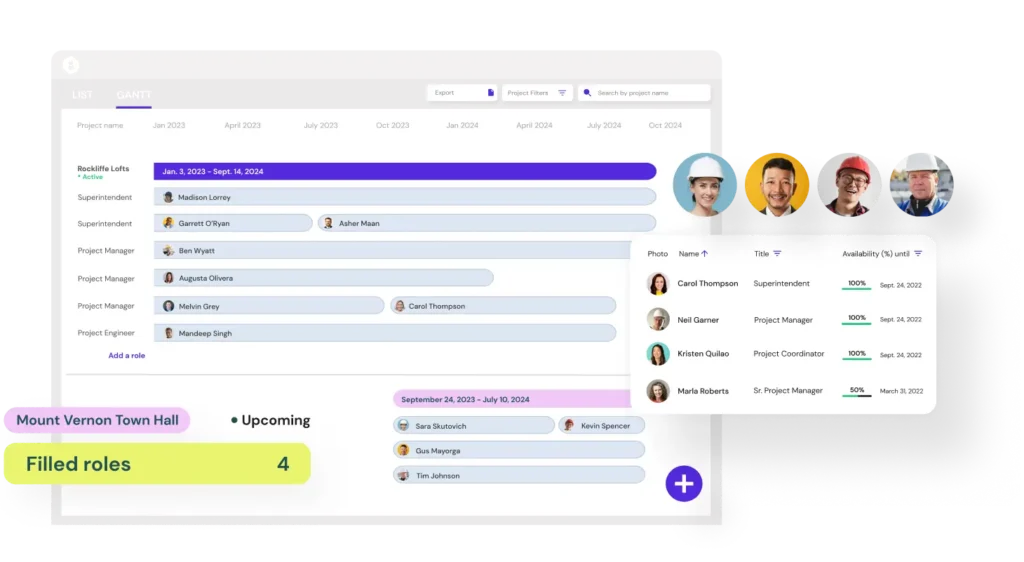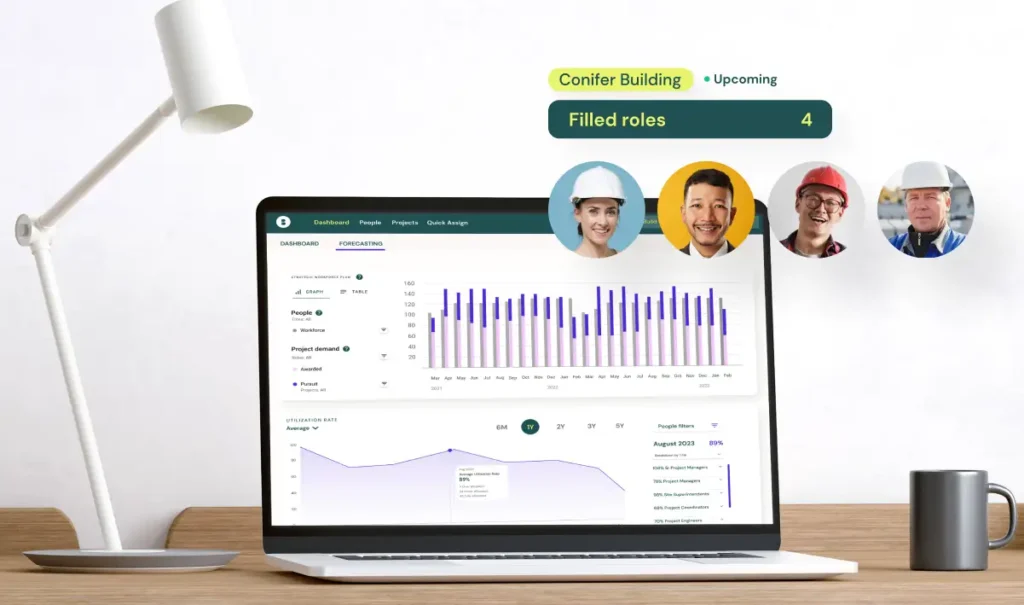Top 8 construction scheduling software in 2024

We’ve compiled eight top options available today if you’re considering upgrading to automated construction scheduling software for your project management and field operations. Keep reading to see a brief overview of each and a high-level comparison.

In its basic definition, resource scheduling in the construction industry is the process and methodology that general contractors will use to allocate their resources to tasks and projects. Given the ever-shifting nature of construction projects, effective construction resource scheduling can be a difficult and time-consuming task for any operations manager.
Scheduling resources becomes increasingly frustrating when the process and methodology include maintaining and exporting important decision-making data from error-prone spreadsheets. This often leads to operations teams making decisions about their resources based on gut feel or potentially inaccurate data. That’s where construction resource scheduling software comes into play.
Construction resource management software allows general contractors to consolidate all relevant resource scheduling data in one centralized location. This helps to streamline the allocating of their resources but also helps to ensure that the right person is assigned to the right project at the right time.
This construction planning software also allows general contractors to take a strategic approach to their resource allocations to help mitigate project risk due to under or over-allocating their project teams. They can also optimize their capacity planning to ensure the supply of resources is aligned with project demands and help forecast workforce allocations to ensure informed recruitment decisions are made.
High-level construction resource scheduling runs deeper than scheduling your workforce and basic labor tracking. Construction projects have many moving parts, the complexity of which good construction employee scheduling software can help manage. On top of scheduling, great resource scheduling (including construction resource scheduling) should include:
- Data collection and analysis – collecting workforce data and analyzing performance to make improvements moving forward
- Performance management – tracking team member output against organizational goals
- Training and mentorships – managing the training of new team members, as well as the career development of current team members
- Recruitment – staying ahead of recruitment must ensure enough time to select qualified, skilled candidates.
- Forecasting – predicting which employees with what skills and qualifications are to be allocated to current and future projects
- Human resource management – managing the people within your organization
The benefits of using construction scheduling software
INCREASE YOUR SCHEDULING EFFICIENCY THROUGH AUTOMATION
Unlike most industries, scheduling in the construction industry isn’t a straightforward, repetitive process. Optimizing for efficient construction management scheduling can often result in headaches for the individuals tasked with creating a strategic resource plan to improve their organization’s bottom line. Team members can spend weeks or months on a specific project and then quickly need to transition to another project once their work is complete.
The tricky part is that most resources required to complete an entire project don’t all wrap up their work simultaneously. This creates many moving parts, requiring operations managers to do mental gymnastics to effectively manage their team’s time. Migrating construction resource scheduling from manual processes like spreadsheets and whiteboards to automated construction employee scheduling software can help to:
- Save time (and money) – The data maintenance and collection required to create an optimized resource schedule can take operations managers countless hours each week. Hours that could be spent on more productive tasks to the organization. Automated construction resource scheduling software can help reduce this time by up to 84% in some cases.
- Make smarter scheduling decisions – It can be a hit to our egos to admit that a piece of software can help us do our jobs better. However, automated resource scheduling software for construction can help to surface relevant decision-making data based on availability, skills and experience, and previous history with clients. This helps build stronger, more balanced project teams without digging through multiple spreadsheets.
- Do more with less – Being more efficient with the people they have by improving their utilization rate and decreasing their bench cost. This can be a surprise, but even the top general contractors sometimes don’t have a live view of who is on a project and who is idle at any given time. This means they could be spending money on staff not assigned to a project.
ALLOW EASY ACCESS TO ANALYTICS AND FORECASTS
The construction industry is collaborative by nature – especially given all of the moving parts of a project. However, operations managers often hesitate to share their workforce data and analytics due to a lack of control over other users. Construction resource scheduling software, like Bridgit Bench, will allow organizational leadership to set specific permission groups for different team members. This allows easy access to workforce analytics and forecasting without risking any unwanted changes or errors.
Commercial construction scheduling software allowing such access will also help general contractors see an improved collaborative effort regarding resource scheduling. With construction timeline software, project management can reference historical data and team member experience to recommend stronger project teams. Human Resources will also be better suited to predict future hiring needs or potential layoffs with access to your workforce forecasting data. Providing your team with easy access to your workforce analytics and forecasts will also help to:
- Increase engagement with your construction resource scheduling via dynamic construction planning software.
- Keep meetings efficient and productive
- Keep stakeholders aligned on strategy from the office to the job site
- Increase accountability
- Uncover new methods of problem-solving and project planning
IMPROVE OUT-OF-OFFICE ACCESSIBILITY OF DATA
Cloud-based construction software helps general contractors to manage their business from anywhere. Through web or mobile applications, stakeholders can easily reference workforce and project progress, data, and metrics from their mobile devices. This means that you can connect with your company anywhere you can connect to the internet.
In the wake of the coronavirus pandemic, the construction industry saw increased demand for technology that can help support teams working remotely. Cloud-based construction timeline software improves accessibility and supports a more collaborative out-of-office work culture. It also helps streamline conference calls and remote resource planning meetings by ensuring all stakeholders look at the same information.
How we evaluated commercial construction scheduling software
COLLABORATION
Construction is collaborative. If a general contractor is migrating their resource scheduling to a cloud-based solution, it should support team collaboration with multiple users. Efforts to improve collaboration and file sharing for general contractors and specialty contractors can often lead to sensitive information being overly accessible. Construction job scheduling software should provide controlled transparency with different levels of user permissions.
INTEGRATIONS
Can the construction management software work with your existing tech stack? Resource scheduling software should complement the tools that you already use.
FEATURES
Migrating to a construction resource scheduling solution should result in abandoning the previously used tool completely. If the features provided aren’t robust enough to accomplish what was done with the previous tool, it can lead to duplicate work needing to be done. Resource scheduling features should be useful and run alongside your other programs.
PRICING
Resource scheduling software for the construction industry doesn’t have to be very expensive. Some resource scheduling tools even allow for unlimited users with no additional fees.
MOBILITY
Is the software cloud-based? Does it have a mobile application? Accessibility across multiple platforms is crucial for construction teams that are on the move, so we prioritized construction job scheduling software, which facilitates that.
EASE OF USE
Ease of use helps garner user buy-in by presenting relevant information in a simple, clean way. General contractor scheduling software should have a simple, intuitive design that provides features to make analyzing data easier, not more complicated than before.
CUSTOMIZATION
Configuring your construction resource scheduling software to your organizational needs is a major benefit for general contractors. This includes customizations like custom people and project fields, construction project phases, and user permission groups.
Top construction scheduling software for 2024
Bridgit Bench
If you’re looking for a workforce management solution that checks all the boxes, look no further than Bridgit Bench. We designed our workforce management solution to create controlled transparency surrounding an organization’s project teams and assignment.
This approach helps support a more collaborative workforce planning process and provides the construction project schedule visibility. It plays nicely with other industry-standard software (like Procore), offers an Open API, has a mobile application for iOS and Android, and boasts robust workflows to plan project teams and refine strategies.
On top of all that, its intuitive design often means that users require no more than an hour of training to use the tool effectively, even for complex tasks like project assignments, forecasting, and pursuit and pipeline management.

PROCORE
Procore offers many integrations for construction companies, including Zapier, Outlook, and Bridgit Bench.
This far-reaching compatibility makes Procore a good program to consider as the centerpiece of your software suite. The intuitiveness of those integrations will also make you quickly forget that Procore isn’t a general contractor software program. Rather, its core features are bidding, budgeting, and – of course – project management.
CONTRACTOR FOREMAN
Contractor Foreman is an all-in-one solution built for smaller general contractors that may be new to construction software. As a construction management solution, it provides contractors with 25+ modules to help with estimating, submittals, accounts, and more. It also integrates with QuickBooks and can be used on mobile devices.
REDTEAM
RedTeam is a project management solution suited for midsize general contractors. It is a cloud-based solution emphasizing construction financials and document control. It was designed to help with estimating, bidding, scheduling, and construction financials. It can also be used for CRM and bid management.
SPECTRUM
Spectrum is best suited for commercial general, heavy/civil, and HVAC contractors. It is a web-based ERP (Enterprise Resource Planning) solution with modules for accounting, equipment and materials, document control, HR and payroll, and inventory. It can be cumbersome software to use effectively, but a wide variety of training and webinars are available to help. However, Spectrum is likely not your program if you’re looking for residential construction scheduling software.
BUILDTOOLS
Buildtools is best suited for custom home builders and remodelers. This residential construction scheduling software helps users organize their project scheduling, budgeting, purchasing, and client communication. It integrates with Quickbooks to reduce duplicate work and has a mobile application to provide accessibility from the office to the job site.
WEBUILD
WeBuild is a project management solution built to promote collaboration. It supports document control and bidding but can fall short if you’re looking for estimating and budget tracking. If you’re looking for a tool that makes project management a collaborative process from the top down, WeBuild may be a good choice for you, but without full buy-in from your whole team, it may result in additional work to keep data updated and maintained.
ORACLE PRIMAVERA
Primavera is a web-based project management solution that offers project scheduling and tools for prioritizing, planning, and managing projects from project controls, portfolio management, document management, and analytics. With the robust feature set, Primavera can be incredibly cumbersome and difficult to learn. If you’re new to construction software, this tool can be complex and present a large learning curve.
How to choose the right construction scheduling software
MAKE SURE TO FIND SOMETHING CONSTRUCTION-SPECIFIC
Construction is a stand-alone industry, given its dynamic nature. Software built specifically for the construction industry should support that and be fully configurable to meet the needs of individual businesses. One-size-fits-all software that is designed to service as many industries as possible often falls short and becomes a temporary “band-aid” solution that doesn’t let them escape their previous resource scheduling process.
CAREFULLY CONSIDER YOUR COMPANY’S SIZE AND NEEDS
What are your organizational goals and objectives? Are you a growing company that wants to track a larger workforce better? Are you a large company that needs a resource scheduling solution that will allow them to focus on specific divisions and offices? Are you a smaller company that wants to be more productive with fewer resources?
Different solutions might be better suited for your organization depending on the number of trackable resources and short/long-term company goals. Check out our construction budget template for more information about budgeting for resources.
CONSULT THE PEOPLE WHO WILL USE THE SOFTWARE
The first indicator is that a resource scheduling solution is a bad fit for your organization. Simple – will it get used? Before investing in a software solution, ask for a demonstration of the tool and invite potential application users to sit in. Ask them questions about how intuitive the tool is, how simple it is to use, and if the information is being displayed in a digestible way.
If you want to improve your team’s collaborative efforts, ensure everyone is on board with implementing new software. This is an easy way to immediately improve buy-in and engagement with the tool.
LIST THE RESOURCES YOU NEED TO SCHEDULE
Having an accurate account of the resources you need to schedule will help you understand if a software solution will benefit your organization and provide a decent ROI. Some general contractors may require enterprise-level resource scheduling software to manage their resources, while others may only need a more basic solution built specifically for smaller teams.
Understanding if your team has grown or stagnated over recent years would also be helpful. Investing in a tool your organization will quickly outgrow could potentially be a headache down the road.
LOOK FOR SOFTWARE THAT INTEGRATES WITH YOUR EXISTING PLATFORMS
If the resource scheduling software you’re seeking is meant to replace an existing solution completely, it should do all the things your previous solution was doing and more. This includes integrating with your existing software stack. Adding new software should help to streamline core processes. If your new software solution isn’t going to talk to your existing software, there’s a chance that it will create duplicate work and have the opposite effect than desired.
Choosing the right construction resource scheduling software for your organization can be a long process, and evaluating multiple platforms can lead to what feels like a bombardment of incoming emails from sales reps. However, if you take the time to establish what goals you are hoping to achieve with your software solution, you can quickly narrow down your options to choose what works best for your organization.
Request demos, full product evaluations, and customer case studies – software representatives should be happy to show off their solutions and clearly communicate the value proposition for your specific goals and objectives.
See whyBridgit Benchis the
#1 Workforce Planning software.
Assign the right people to the right projects, transform how you forecast labor needs,
and unify your workforce and pursuit planning. Schedule a demo to learn more.
